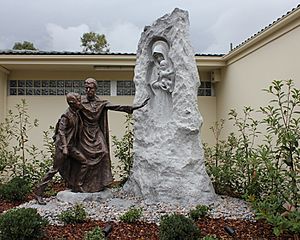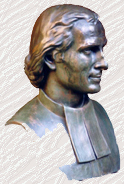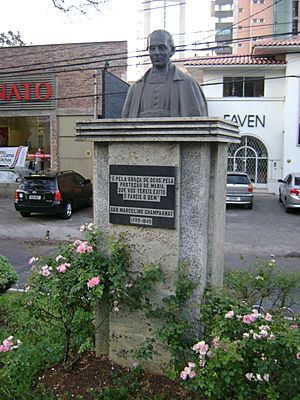Marcellin Champagnat facts for kids
Quick facts for kids SaintMarcellin Champagnat FMS |
|
|---|---|

Official portrait of Marcellin Champagnat
|
|
| Priest & Founder | |
| Born | 20 May 1789 Le Rosey, France |
| Died | 6 June 1840 (aged 51) Saint-Chamond, France |
| Venerated in | Catholic Church |
| Beatified | 29 May 1955, The Vatican by Pope Pius XII |
| Canonized | 18 April 1999, The Vatican by Pope John Paul II |
| Feast | 6 June |
| Patronage | Education, teachers, and simplicity |
Marcellin Joseph Benedict Champagnat, also known as Saint Marcellin Champagnat, was born in France on May 20, 1789. This was the same year the French Revolution began, a time of big changes in France. These changes in society, politics, and religion helped shape his life and goals.
Marcellin Champagnat became a Catholic priest. He is famous for founding the Marist Brothers. This is a group of religious brothers dedicated to education. They focus on teaching children, especially those in rural areas who might not have access to good schools. His feast day, a special day to remember him, is June 6.
Contents
Becoming a Priest: Marcellin's Journey

Marcellin started his studies at the Minor Seminary in Verrières-en-Forez in 1805. He was 17 years old, older than many of his classmates. He struggled at first and was even sent home after his first year. But with help from his mother and parish priest, he was allowed back.
At first, Marcellin was a very social young man. He enjoyed spending time with friends. However, he soon decided to focus more on his studies. Two important events helped him change. One was the sudden death of his friend, Denis Duplay. The other was a serious talk with his seminary supervisor about improving his behavior.
After this, Marcellin moved to the major seminary at Saint Irenaeus in Lyon. Here, he continued his training to become a priest. He wasn't naturally a top student, but he worked very hard. With support from his family, he was finally ordained as a priest on July 22, 1816.
The Idea for the Society of Mary
While at the seminary, Marcellin and some friends had an idea. They wanted to create a new religious group called the Society of Mary. This group would be dedicated to Mary.
The day after his ordination, Marcellin and his friends went to a special church dedicated to Mary. There, they promised to work together to form this new society. From the very beginning, Marcellin believed this group should include teaching Brothers. He wanted them to help children in faraway places who didn't have a good Christian education.
Founding the Marist Brothers: A New Beginning
After becoming a priest, Marcellin was sent to work in a town called La Valla. This area was very rural, and people lived far apart. Marcellin quickly saw that many children here had little to no education.
One day, in October 1816, he visited a dying 16-year-old boy named Jean-Baptist Montagne. The boy knew very little about basic Catholic teachings. This experience deeply affected Marcellin. It made him even more determined to create a group of religious Brothers who could teach children.
Marcellin's Vision for Education
Marcellin believed that to teach children well, you must first love them. He told the Marist Brothers to "Keep loving them as long as they are with you." He also said, "Love them all equally—no outcasts, no favourites." He famously stated, "I cannot see a child without wanting to tell him how much God loves him."
On January 2, 1817, Marcellin invited two young men, Jean-Marie Granjon and Jean-Baptiste Audras, to join him. This was the start of the Marist Brothers. Soon, more young men joined them in La Valla. This town became the birthplace of the Marist Brothers.
In 1817, he opened a small place to train teachers in La Valla. This became the first center for his young Brothers. As the group grew, they needed more space. In 1824, they built a larger training center called the Notre Dame Hermitage. From there, the Brothers began to spread their work more widely.
Growing the Marist Schools
In the early years, Marcellin personally guided the Brothers. He visited their schools and even helped with the teaching. By 1833, many young men in their late teens and early twenties were joining the Brothers. They learned to read and write, studied religious teachings, and trained to become teachers. They followed a daily schedule of prayer, study, and work.
The Brothers started in small country parishes but soon expanded to larger towns. In 1818, Marcellin opened the first Marist school. He designed the school's schedule to fit the needs of farming families. For example, children could be off school to help with planting and harvesting. He also made sure the school fees were affordable for most rural families. If a family couldn't pay, tuition was free.
Marcellin had a special devotion to guardian angels. He asked that a picture of a guardian angel be placed in every classroom. This showed his belief in protecting and guiding children.
Encouraged by the success in La Valla, more schools were opened. These included schools in Marlhes (1819), Saint-Sauveur-Street (1820), and Bourg-Argental (1822). The number of Brothers grew, allowing them to open even more schools in other towns.
In 1837, Marcellin wrote a "Rule" or guide for his Brothers to follow. As his health declined, he asked the Brothers to choose a successor. Brother François Rivat was chosen as the new leader on October 12, 1839.
Marcellin's Final Years and Legacy
Marcellin Champagnat passed away on June 6, 1840, at the age of 51, after a long illness. He died at Our Lady of the Hermitage, the larger training center he had built. He left a powerful message for his Brothers: "Let there be among you just one heart and one mind. Let it always be said of the Little Brothers of Mary as it was of the early Christians: See how they love one another!"
At the time of his death, there were 278 Brothers and 48 Marist schools in France. The order was also starting to spread to the South Pacific. The group was formally approved by Pope Pius IX in 1863 and given the name Institutum Fratrum Maristarum a Scholis. Members of the order use the initials "FMS."
Marcellin's Enduring Influence
Marcellin Champagnat was declared "Venerable" in 1920. He was then "beatified" by Pope Pius XII in 1955. Finally, he was "canonised" (declared a saint) by Pope John Paul II on April 18, 1999. His feast day is celebrated on June 6.
When Marcellin died, there were 280 Marist Brothers. By 1856, this number grew to 1,500. Today, there are about 5,000 Marist Brothers and tens of thousands of other people who help spread Marist education. They work in 74 countries around the world.
Marcellin never wrote a long book about his teaching ideas. But his main belief was simple: to teach children, you must love them. He thought that teaching regular subjects well would attract children to schools. Once there, they would also learn about their faith. He believed God was at the center of life and that the Virgin Mary was a sure way to help people connect with God.
See also
 In Spanish: Marcelino Champagnat para niños
In Spanish: Marcelino Champagnat para niños
- Peter Chanel
- Peter Julian Eymard
- John Vianney
Images for kids




